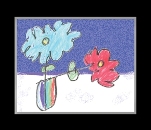Embroidery is the technique of decorating fabric or other surfaces with thread using ornamental stitches. Embroidery on paper can be combined with photos, ribbon, fabric, stickers, paint, markers and other materials and techniques to create many different effects and greeting card styles both traditional and contemporary.
Embroidery on paper patterns are available from a variety of sources, including the internet, the library and arts and craft stores, but any simple line art drawing can make a good paper embroidery pattern. Clean lines with little detail like a simple flower or the outline of a Christmas tree, birthday cake or house make a good design. Tracing paper also works well to trace designs from books or other sources.
Lesson Plan Suggestion: The same basic stitches that can be used to create an embroidery on paper card face are the same ones that have been used throughout history in cultures around the world from ancient Egypt to modern times, making embroidery on paper a great art project to incorporate into almost any history or geography lesson plan. Paper embroidery can be as simple as a straight stitch following an outline all the way to complicated geometrical patterns, so this technique can be adapted for children in a wide range of ages as well as adults.
- First you need to transfer a paper pattern onto the My Art Cards template card using a sharp point like a push pin, embroidery needle or a stylus. Lay the card template on a flat cushioned surface like a piece of felt, folded dishrag or even a heavy sock and place the paper pattern on the front of the card. You can use blue painter’s removable tape or some other removable tape to hold the pattern in place.
- You can also embroider a separate piece of card stock and glue it or use double sided tape to attach it to the My Art Cards template card rather than embroider the My Art Cards template card directly.
- If you have drawn your own design, make pencil marks on the pattern about every 1/4 to 1/2 each being sure to space the marks evenly along the design.
- After you have placed your pattern on top of your card stock, use your push pin or other pointed instrument to pierce holes at each marked point on the pattern. Always hold your piercing tool vertically.
- Once you have perforated the entire design, remove the pattern from the card template and hold the pattern up to the light to see if you have pricked out all the marked points. Keep the pattern to reference while you complete your design.
- Thread an embroidery needle (Number 10 or Number 11 embroidery needles work well) with your embroidery thread. Do not use the embroidery needles with blunt tips because they are too thick and will tear holes in the card stock. The width of the needle must always be thinner than the piercing tool.
- Cut your embroidery thread to a length of about 14 inches. Short lengths are less likely to get caught on the corner of your card or to knot up. Short lengths also avoid excessive abrasion on the thread from repeated passes through the holes in your card.
- Machine embroidery thread that comes on a spool works better than skeins of embroidery thread because the machine embroidery thread is thicker and does not unravel as easily.
- Vari-colored embroidery thread can give an interesting effect, but do not use metallic threads because just like glitter, they will not reproduce well for My Art Cards.
- Tie a knot in one end of the thread to begin or leave about an inch of thread hanging loose and fasten the end of the thread to the back of the card with a small piece of tape outside the borders of the pattern.
- Starting from the back, pull the thread completely through each hole but do not over tighten or the card will be bowed. If your thread gets twisted, let your needle hang free to allow the thread to untwist.
- Stitching can be as simple as an outline running stitch or more decorative stitches like an outline (stem) stitch or laisy daisy stitch can be used. There are many sources in the library and on the Internet about paper embroidery and different techniques for embroidery stitches.
- The running stitch is the classic sewing stitch of up, down, up, down evenly spaced in a line so that the line looks like a row of dashes.
- The basic outline back stitch is worked from right to left in a two holes forward, one hole back fashion, making a continuous line of thread on the pattern outline.
- The lazy daisy stitch comes up from the back and then makes a loop on the front by poking the needle back down beside where it came up and leaving the thread loose. At the point of the loop, come up from behind again and tack the end of the loop down with a tiny stitch. Repeat for each petal of your daisy.
- After you have made your stitches, fasten the end of the thread on the underside of the card by looping it around an adjacent stitch and knotting it tightly. You can also secure the end with a small piece of masking or other tape.
